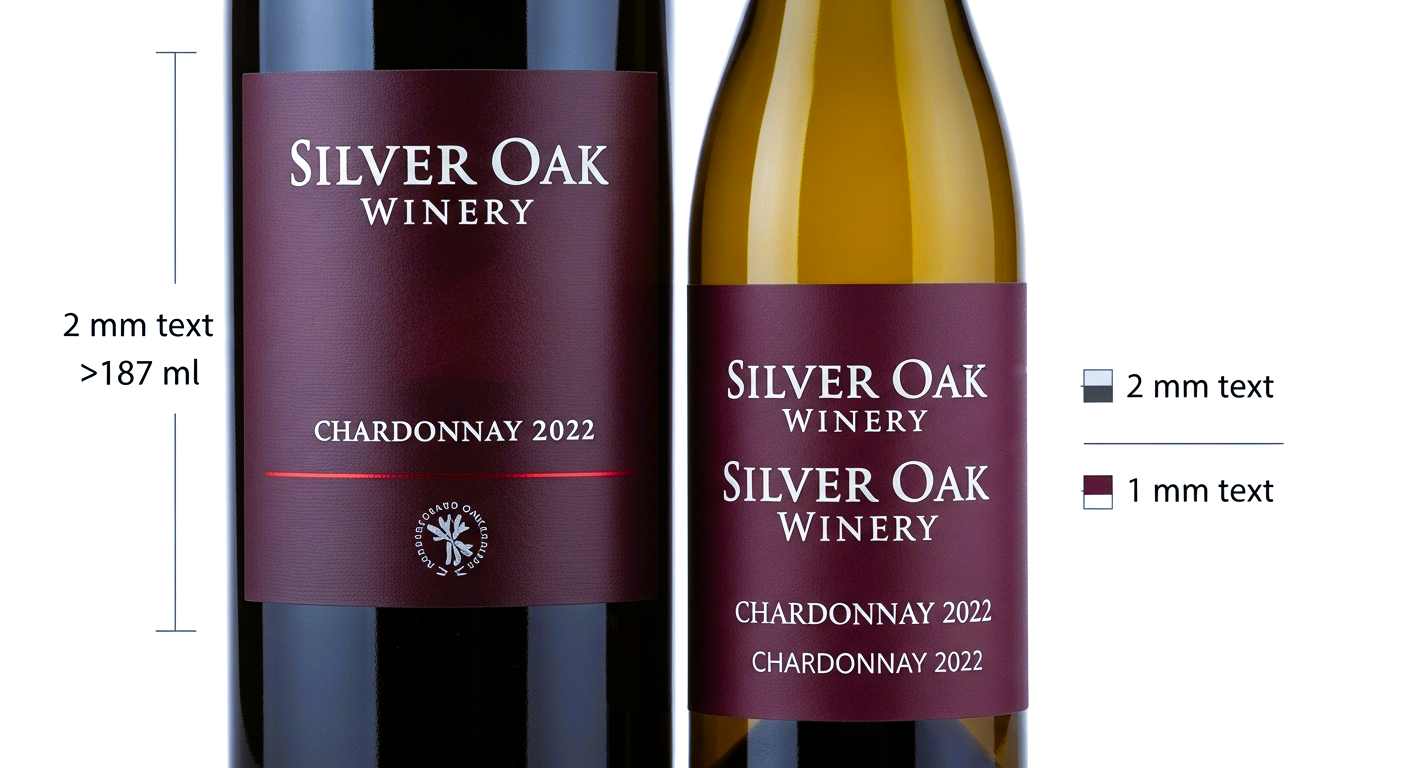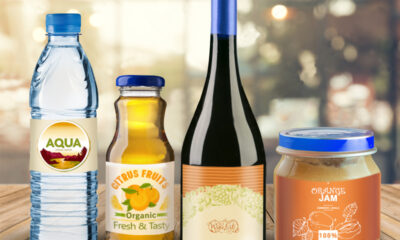New to winemaking? Learn the TTB label rules every winery must follow, from brand name to ABV, to ensure your wine is legal and ready to sell.
This lists all TTB’s mandatory requirements for wine labels to help you avoid common labeling errors.
1. Brand Name

The brand name, also known as producer identification, is typically the name of the winery or winemaker. But in the absence of a brand name, TTB requires the use of the wine producer’s name.
Every wine label should have a brand name, which is often the most prominent information on it.
Optional: Some wine producers add a “sell name,” which is a descriptive word or phrase used to further identify their products. The TTB mandates that it should not create a false or misleading impression about a wine product.
Formatting Requirements:
- For containers larger than 187 ml, the text should be at least 2 mm. This minimum type size requirement applies to numerals and lowercase letters.
- For containers of 187 ml or less, the minimum type size is 1 mm.
- The brand name should be legible under ordinary conditions.
- It should appear on a contrasting background.
- It must be separate and substantially more visible than other descriptive or explanatory information on the wine label.
Examples of Sell Names:
Rose Wine, Amber Wine, Sunset Rose, and Scarlet Wine
2. Class or Type Designation
This information pertains to the type of wine. Common examples include “Peach Wine,” “Red Wine,” “Sparkling Wine,” “Merlot,” “Table Wine,” and “Chardonnay.”
If a bottled wine uses multiple grape varieties (or wine blends), the TTB stipulates that companies must specify the percentage of each grape, which should total 100%.
Example:
This red wine is a blend of 60% CABERNET SAUVIGNON and 40% MERLOT.
Formatting Requirements:
- The Class or Type Designation must be displayed more conspicuously than any other surrounding text.
- The grape varietals and their percentages must be printed in a type size of at least 2 mm.
- For wine blends, the percentage of grape varietals must be stated.
Example:
50% American wine / 50% French wine
3. Appellation of Origin
The Appellation of Origin pertains to the area where the grape (or any agricultural product) used to make the wine was grown. It can be a country, state, county, or American Viticultural Area (AVA), which is a designated wine grape-growing region in the United States.
Some wine producers add the “Vintage Date” (e.g., 2022) above the Appellation of Origin. This optional information pertains to the year when the grapes were harvested.
Formatting Requirements:
- The Appellation of Origin must appear in direct conjunction with, and as conspicuous as, the Class or Type Designation.
- For containers of 187 ml or less, the Appellation of Origin must have a type size of at least 1 mm.
- For containers of over 187 ml, the Appellation of Origin must be at least 2 mm in size.
- This information must be readily legible under ordinary conditions.
- It must appear on a contrasting background.
- It must be separate and substantially more visible than other descriptive or explanatory information on the wine label.
Example:
Napa Valley and Red Mountain (AVA)
California and Colorado (States)
4. Alcohol Content
The alcohol content by volume (ABV) of a bottled wine may appear as a specific number or range. All wine products with over 14% ABV are required to have this information on their labels.
However, wine products with 7-14% ABV may choose not to include this information if the Class or Type Designation on the label says “Table Wine” or “Light Wine.
Formatting Requirements:
- These are the acceptable abbreviations: “Alc.”, “Alc”, “Vol.”, “Vol” or “%”.
- For containers of 5 liters or less, the ABV must have a type size between 1 mm and 3 mm. This requirement applies to all numerals, symbols, and uppercase and lowercase letters.
- It must appear on a contrasting background.
Example:
Alcohol __% by volume
5. Net Contents
This information pertains to the volume of wine in a container and is typically measured in milliliters (ml) and liters (L).
Check out the Code of Federal Regulations’ list of authorized metric standards of fill for wine.
Formatting Requirements:
- If the volume is more than 1 liter, Net Contents are stated in liters and a decimal portion of it written to the nearest one-hundredth.
- If the volume is less than a liter, Net Contents must be stated in milliliters (ml).
Example:
1.5 L, 3 L, 300 ml, and 700 ml
6. Name and Address
This information pertains to the city and state listed on your business permit. It is typically preceded by phrases like “Bottled by,” “Packed by,” “Vinted by”, “Produced by”, “Blended by,” and “Made by.”
Some wine products may require more information beyond the Name and Address. For example, a wine brand produced at one location and bottled at another must state two different locations on its label.
7. Health Warning
Any alcoholic beverage with an alcohol content of 0.5% or higher that is for sale or distribution must have Health Warning Statements.
Formatting Requirements:
- The words “GOVERNMENT WARNING” must be capitalized and in bold type.
- The remainder of the warning must not be bold but may be in all caps.
- The “S” in Surgeon and “G” in General must be capitalized.
Examples:
GOVERNMENT WARNING: (1) ACCORDING TO THE SURGEON GENERAL, WOMEN SHOULD NOT DRINK ALCOHOLIC BEVERAGES DURING PREGNANCY BECAUSE OF THE RISK OF BIRTH DEFECTS. (2) CONSUMPTION OF ALCOHOLIC BEVERAGES IMPAIRS YOUR ABILITY TO DRIVE A CAR OR OPERATE MACHINERY, AND MAY CAUSE HEALTH PROBLEMS.
8. Sulfite Declaration
A wine label should have a Sulfite Declaration (e.g., “Contains Sulfites or “Contains a Sulfating Agent”) if the total sulfur dioxide or a sulfating agent is detected at a level of 10 or more parts per million (ppm).
If your wine does not contain sulfites or the level is below 10 ppm, the Sulfite Declaration is not required. However, you have to submit a lab analysis to the TTB together with your COLA application to prove your claim.
You may use the phrase “No sulfites added” on your wine label as long as it appears together with a “Contains naturally occurring sulfites” statement.
Final Thoughts
Once your COLA application has been approved, you can start bottling your wine (make sure you pick the authorized metric standards of fill) and print your wine labels.
The right material for your wine labels depends on where the bottles will be stored. For products that will be primarily stored and displayed indoors, white paper is a suitable option, while those that will be refrigerated are best suited for BOPP-made labels.
BOPP is a refrigerator-safe, waterproof, tearproof, and oil-resistant material, making it a popular choice among wine producers and bottlers.


